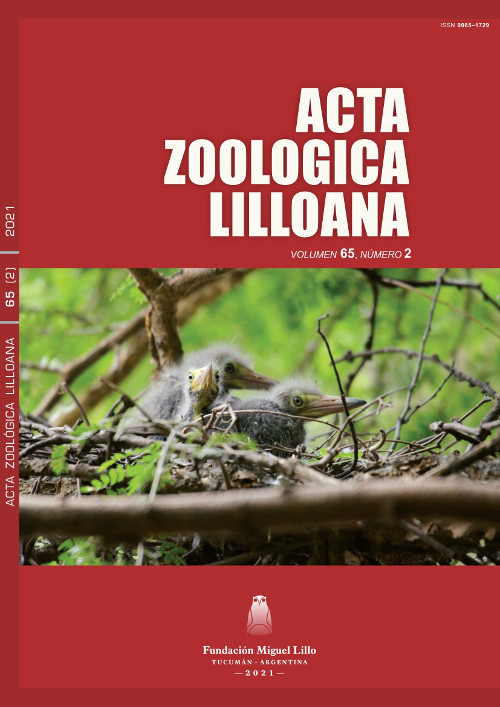Uso de una colmena centinela de Apis mellifera (Hymenoptera: Apidae) para evaluar presencia de plaguicidas y sus fuentes de alimentación
DOI:
Palabras clave:
Coumafos, comportamiento de pecoreo, manejo de abejas melíferas, polen, espiridiclofenoResumen
Las poblaciones de abejas melíferas están disminuyendo, como ocurre con otros polinizadores. Una de las causas sugeridas de este declive es el impacto de los pesti- cidas. Para mejorar la salud de las abejas, se pueden monitorear los pesticidas y las fuentes de alimentación mediante colmenas centinela, dado que las abejas pecorean en un radio de 2,5 km alrededor de la colmena. Extrajimos 20 (veinte) abejas, así como muestras de cera, miel y polen de una colmena centinela. Se detectaron seis plaguicidas en las muestras, excepto en la miel. Todos los plaguicidas detectados en la colmena centinela están prohibidos en Argentina. Se detectaron ocho familias y géneros de plantas diferentes en las muestras de miel y polen. Nuestro trabajo sugiere que el monitoreo de plaguicidas con colmenas centinela será útil para mejorar las prácticas agrícolas en la región.
Descargas
Citas
Ayup, M. M., Gärtner, P., Agosto-Rivera, J. L., Marendy, P., de Souza, P., Galindo Cardona, A. (2021). Analysis of Honeybee Drone Activity during the Mating Season in Northwestern Argentina. Insects, 12, 566. https://doi.org/10.3390/insects12060566
Chalup, A., Ayup, M. M., Monmany Garzia, A. C., Malizia, A., Martin, E., De Cristobal, R., Galindo-Cardona, A. (2018). First report of the lesser wax moth Achroia grisella F. (Lepidoptera: Pyralidae) consuming polyethylene (silo-bag) in northwestern Argentina. Journal of Apicultural Research, 57, 569–571. doi:
1080/00218839.2018.1484614.
Couvillon, M. J., Riddell Pearce, F. C., Accleton, C. Fensome, K. A. Quah, S., Taylor, E. L., Ratnieks, F. (2015). Honey bee foraging distance depends on month and forage type. Apidologie, 46, 61–70. https://doi.org/10.1007/s13592-014-0302-5
Enviromental Protection Authority. (2018). Science memo for the reassessment of the approval to import or manufacture Luna Sensation for release (APP203261). pp: 27.
Gallo Mendoza, G. (2006). Agroquímicos prohibidos o restringidos: Normas Reguladoras de Procedimientos para evitar la contaminación. PRAT-DNAyF-SSAGyF-SAGPyA-ME.(http://www.alimentosargentinos.gob.ar/bpa/bibliografia/Minagro_Agroquimicos_prohibidos.pdf).
García, M. D. G., Duque, S. U., Fernandez, A. B. L., Sosa, A., Fernandez-Alba, A. R. (2017). Multiresidue method for trace pesticide analysis in honeybee wax comb by GC-QqQ-MS. Talanta 163, 54–64.
Gregorc, A., Alburaki, M., Rinderer, N., Sampson, B., Knight, R. P., Karim, S., Adamczyk, J. (2018). Effects of coumaphos and imidacloprid on honey bee (Hymenoptera: Apidae) lifespan and antioxidant gene regulations in laboratory experiments. Scientific Reports, 8, 15003.
Herrera López, S., Lozano, A., Sosa, A., Hernando, M. D., Fernández-Alba, A. R. (2016). Screening of pesticide residues in honeybee wax comb by LC-ESI-MS/MS. A pilot study. Chemosphere.
https://doi.org/10.1016/j.chemosphere.2016.07.008
Imtrade Australia. Imtrade Carbendazim 500SC Fungicide. Safety data sheet. (2014). pp: 5.
Intergovernmental Science-Policy Platform on Biodiversity and Ecosystem Services
(IPBES). (2016). The assessment report on pollinators, pollination and food prodution. pp 152-188.
IUPAC. Pyraclostrobin (Ref: BAS 500F). (2021).
Kochansky, J., Wilzer, K., Feldlaufer, M. (2001). Comparison of the transfer of coumaphos from beeswax into syrup and honey. Apidology 32, 119-125.
Mao, W., Schuler, M. A. Berenbaum, M. R. (2013). Honey constituents up-regulate honey bee genes. Proceedings of the National Academy of Sciences of the United States of America. 110, 8842-8846.
Minnesota Department of Agriculture. https://www.mda.state.mn.us/protecting/bmps/pollinators/beetoxicity
Niell, S., Jesús, F., Pérez, N., Pérez, C., Pareja, L., Abbate, S., Carrasco Letelier, L., Díaz, S., Mendoza, Y., Cesio, V., Heinzen, H. (2017). Neonicotinoids transference from the field to the hive by honey bees: Towards a pesticide residues biomonitor. Science of Total Environment 581–582, 25–31.
Poquet, Y., Vidau, C., Alaux, C. (2016). Modulation of pesticide response in honeybees. Apidologie 47, 412–426. https://doi.org/10.1007/s13592-016-0429-7
Porrini, C., Mutinelli, F., Bortolotti, L., Granato, A., Laurenson, L., Roberts, K., Gallina, A., Silvester, N., Medrzycki, P., Renzi, T., Sgolastra, F. & Lodesani, M. (2016). The Status of Honey Bee Health in Italy: Results from the Nationwide Bee Monitoring Network. PLoS ONE 11, e0155411. https://doi.org/10.1371/
journal.pone.0155411
Requier, F., Antúnez, K., Morales, C., Aldea Sánchez, P., Castilhos, D., Garrido, P., Giacobino, A., Reynaldi, F., Rosso Londoño, M., Santos, E., Garibaldi, L. (2018) Trends in beekeeping and honey bee colony losses in Latin America, Journal of Apicultural Research, 57:5, 657-662, DOI: 10.1080/00218839.2018.1494919
Smart, D. M., Pettis, S. J., Eulis, N., Spivak, S. M. (2016). Land use in the North Great Plains region of the U.S. influences the survival and productivity of honey bee colonies. Agriculture, Ecosystems and Environment 230, 139-149.
Traynor, K., Pettis, J., Tarpy, D. R., Mullin, A. C., Frazier, L. J., Frazier, M., vanEngelsdorp, D. (2016). In-hive Pesticide Exposome: Assessing risks to migratory honey bees from in-hive pesticide contamination in the Eastern United States. Scientific Reports 6, 33207. https://doi.org/10.1038/srep33207
UNIVERSAL Crop Protection (Pty) Ltd. Material safety data sheet. Universal ametryn 500sc. (2015). pp: 3.
Van der Steen, J. J., de Kraker, J., Grotenhuis, T. (2015). Assessment of the potential
of honeybees (Apis mellifera L.) in biomonitoring of air pollution by cadmium,
lead and vanadium. Journal of Environmental Protection, 6, 96.
Vázquez, D. E., Balbuena, M. S., Chaves, F., Gora, J., Menzel, R., Farina, W. M. (2020). Sleep in honey bees is affected by the herbicide glyphosate. Scientific Reports, 10, 1-8.
Williamson, S. M., Wright, G. A. (2013). Exposure to multiple cholinergic pesticides impairs olfactory learning and memory in honeybees. Journal of Experimental Biology, 216, 1799–1807.
Descargas
Publicado
Cómo citar
Número
Sección
Licencia
Derechos de autor 2021 Fundación Miguel Lillo

Esta obra está bajo una licencia internacional Creative Commons Atribución-NoComercial-SinDerivadas 4.0.









